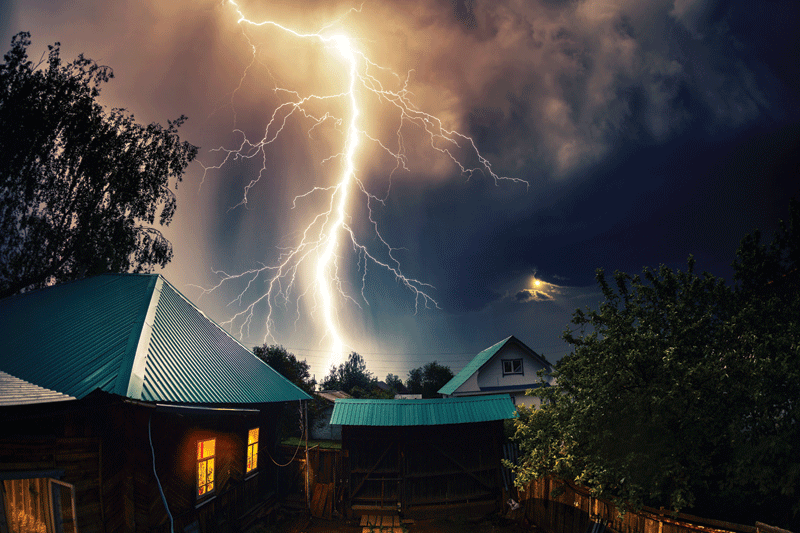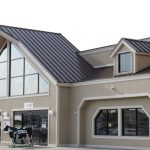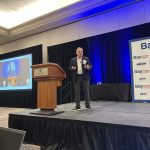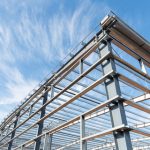
Metal roofing is known for its durability, sustainability, and versatility. It is considered the most environmentally friendly roofing material available. With a 98 percent recycling rate1, the maintenance requirements and life cycle ownership costs are substantially lower than the alternatives. However, there are many misconceptions about metal roofing.
From cellphone interference to lightning strikes to noise on the roof, the industry needs to dispel some of the many myths about metal roofing so contractors can help their clients make good roofing decisions.
Myth 1: Metal roofs are noisy when it rains
Remember a time standing under a metal roof when it rained or hailed? It was probably in an uninsulated warehouse, barn, shed, or porch, and the sound transmitted straight to the ears. Metal roofing, like any other roofing, experiences noise induced by heating/cooling, rain, and hail, for example. The bigger question is: To what degree is the noise muted before it reaches a person’s ears inside the building? Since metal is a hard surface, it tends to transmit noise more than asphalt shingles, for example. Therefore, the real question is: Where does the noise go?
For common residential construction, it goes into the underlayment material and wood deck, which absorbs most of the sound. Some sound is transmitted into the attic space and absorbed by the attic floor, its insulation, and the interior drywall ceiling. Fiberglass or cellulose insulation has excellent sound absorption characteristics. In the case of a cathedral ceiling, it may transmit more noise to the interior depending on the composition of the ceiling. Compact roof assemblies like structural insulated panels (SIPs)—with interior hardboard, exterior hardboard, and rigid foam insulation between—are the worst acoustically, but this is true whether the roof is metal or shingle. A thin layer of fiberglass blanket insulation between the metal roof and the wood deck will deaden most sound.
Myth 2: A metal roof makes a home warmer inside
A metal roof will not make a home warmer inside, but it will make it cooler in the summer. Metal has low thermal mass and—with the infrared- (IR-) reflective pigments used in finishes today—high reflectivity and emissivity. So, it does not store as many BTUs as other materials and reflects most of the solar spectrum that generates heat. Regarding roof assemblies, the best way to reduce heat transfer from the inside (making it warmer) is to add more insulation to the attic floor and check the seals of windows and doors. This is usually a prudent economic decision in any event. These measures will reduce energy consumption and fuel bills—both heating and cooling.
Myth 3: Metal roofs impact cellphone and satellite reception
Depending on the particulars, cell and satellite signals are generally the line of sight. They will pass through other materials better than metal. A steep metal roof with habitable space beneath it may cause some cell signal loss. To obtain a better signal inside the house, use a cell booster. Satellite dishes are mounted outside on a roof, wall, or ground, so they are exempt from this issue.
Myth 4: It is always necessary to remove an old shingle roof before installing a metal roof
Mandates about existing asphalt roof removal involve both building code and practical matters. Model codes generally mandate that reroofing can take place only once over an old roof. (No more than two roofs total in place.) The concerns are both weight and the irregular surface that can result from multiple roof layers beneath. Asphalt shingle roofing is much heavier than metal roofing, and the metal roof performance seldom relies on the irregular surface below it. Most model codes recognize that metal roofs are different in this regard and allow an exception to this mandate when the third roof is metal.
If the existing shingle roof is badly aged, cupped, and distorted, overlaying it may not be the wisest thing to do from an aesthetic perspective. However, there are ways to mitigate these problems, such as using light gauge furring channels or “stand-off” attachment clips.
Myth 5: Homes with metal roofs are more likely to be struck by lightning
It seems intuitive to expect that a metal roof “attracts” lightning, but it is a complete misconception. Lightning finds its way to earth based primarily on building height as compared to its surrounding terrain, structures, or trees, so a metal-roofed home is no more likely to be struck than any other roof. Most damage (along with fires) resulting from lightning strikes is caused by the lightning charge passing through non-conductive materials like wood, masonry, or stone on its way to the ground. So, a steel-framed, metal-roofed building is the safest place to be during a lightning storm because the potential strike has an easy, conductive path to the ground. Just keep some distance from that path. (Do not stand next to the walls.) The human body is mostly water, which is highly conductive.
For wood-framed structures, run a grounding cable from the metal roof to the ground. This is not an “approved” lightning protection system in the U.S. but works well all over the world and is code-mandated in most of Europe. (No code mandates exist in the U.S.) If the roof is non-metal, the use of an “approved” lightning protection system to reduce the chance of damage from a lightning strike is prudent. The Metal Construction Association (MCA) provides two technical reports about lightning.2
Myth 6: A metal roof is heavy
Metal is the lightest common roofing alternative. Asphalt shingles generally weigh between 9 and 19 kg/m2 (2 and 4 psf), depending upon the grade of shingle. Concrete and clay tiles weigh 29 to 68 kg/m2 (6 to 14 psf). Metal weighs 3 to 6 kg/m2 (0.7 to 1.3 psf), depending upon material type and gauge.
Myth 7: Metal roofs corrode
Every metal corrodes over time when exposed to air and moisture—even gold. However, the rates of corrosion vary. Corrosion is not necessarily a bad thing and has numerous synonyms: oxidation, weathering, patination, and tarnishing, to name a few. The metal oxide (corrosion) layers are different in chemistry than the base metal that created them and, in most cases, retard the further corrosion process of the base metal. Metals that corrode rather quickly, such as steel, are protected by a layer of zinc or zinc-aluminum alloy that corrodes much more slowly.
A specific alloy of 55 percent aluminum and 43 percent zinc is known by the trade names Galvalume and Zincalume. Field and laboratory studies of 55 percent Al-Zn-coated steel done by the MCA estimate this material’s service life at more than 70 years. Copper has an expected life of 150-plus years, as does pure zinc sheet. Some stainless-steel alloys have an expected service life of 200-plus years. The rate of corrosion for all metals is accelerated in severe salt spray (acetic) environments—some more so than others.
The expected life of asphalt shingles is between eight and 25 years, depending upon the grade of the shingle. In the hail belts of the U.S., the expected life is shorter because shingles become more brittle with age.
Myth 8: Hail easily dents a metal roof
It depends upon the size and hardness of the hailstones, the type and gauge thickness of metal, the substrate to which it is installed, and the definition of easily. Steel roofs do not dent from hail as easily as a car, which uses softer grades of steel that can be easily molded into the sleek lines and curves of an auto. Generally, up to 25-mm (1-in.) hail will barely leave a trace on a 24-gauge steel roof. Contrary to the claims of many “storm-chaser” contractors, it is extremely rare that hailstorms, even of significant hail-size magnitude, inhibit a roof’s function, mandating its replacement. Claims to the contrary are generally ill-founded.
Myth 9: The fasteners used to install metal roofing will leak
Over time, metal panels go through cyclic expansion and contraction with changes to their temperature. The amount of “thermal movement” is directly proportional to the roof panel’s length. Thermal movement can eventually fatigue direct fastening—especially with greater panel lengths and inflexible substrates (like a wood deck). If the fastening fatigues, some screw “back out” may be experienced, and the weatherproof seal can be disrupted—resulting in leaks. It may also put the roof in jeopardy of wind damage. Other things being equal, the greater the panel’s length, the more prone to thermal fatigue its fastenings are.
To avoid issues of mis-installation and thermal fatigue, avoid panels that are attached directly. Use clip-attached standing seam panels instead. They are more expensive but do not require direct attachment, so there are no holes. Instead, they attach with concealed clips that enable the panels to cycle thermally without fastening fatigue, providing a maintenance-free, durable attachment. Standing seam addresses both issues: thermal fatigue and holes through the weathering surface.
Myth 10: A metal roof may blow off
Wind causes uplift (suction) forces on a roof. A metal roof can be tailored to withstand virtually any uplift force desired or mandated by building code authorities up to and including Category 5 hurricane forces. This degree of wind resistance is not something that magically happens but is the result of careful design, engineering, testing, attachment, and installation details. Unlike many other roofing materials, metal’s mechanical properties do not change with age, so it will perform as designed for its long service life.
For more information, visit metalconstruction.org or metalroofing.com.
Notes
1 Modern Steel Construction, “Sustainability By the Numbers,” May 2023
2 See metalconstruction.org/view/download.php/online-education/education-materials/roofing-educational-materials/lightning-strikes-and-metal-roofing or metalconstruction.org/view/download.php/online-education/education-materials/roofing-educational-materials/best-practices-in-lightning-protection-and-metal-construction
Rob Haddock is a metal roof consultant, author, speaker, inventor, and the CEO and founder of Colorado Springs, Colo.-based S-5! He is director of the Metal Roof Advisory Group Ltd., an international consulting firm. Haddock has nearly 50 years of experience in the metal construction industry, is an in-demand speaker, and is a member of the inaugural class for the Metal Construction Hall of Fame. To learn more, go to s-5.com.





